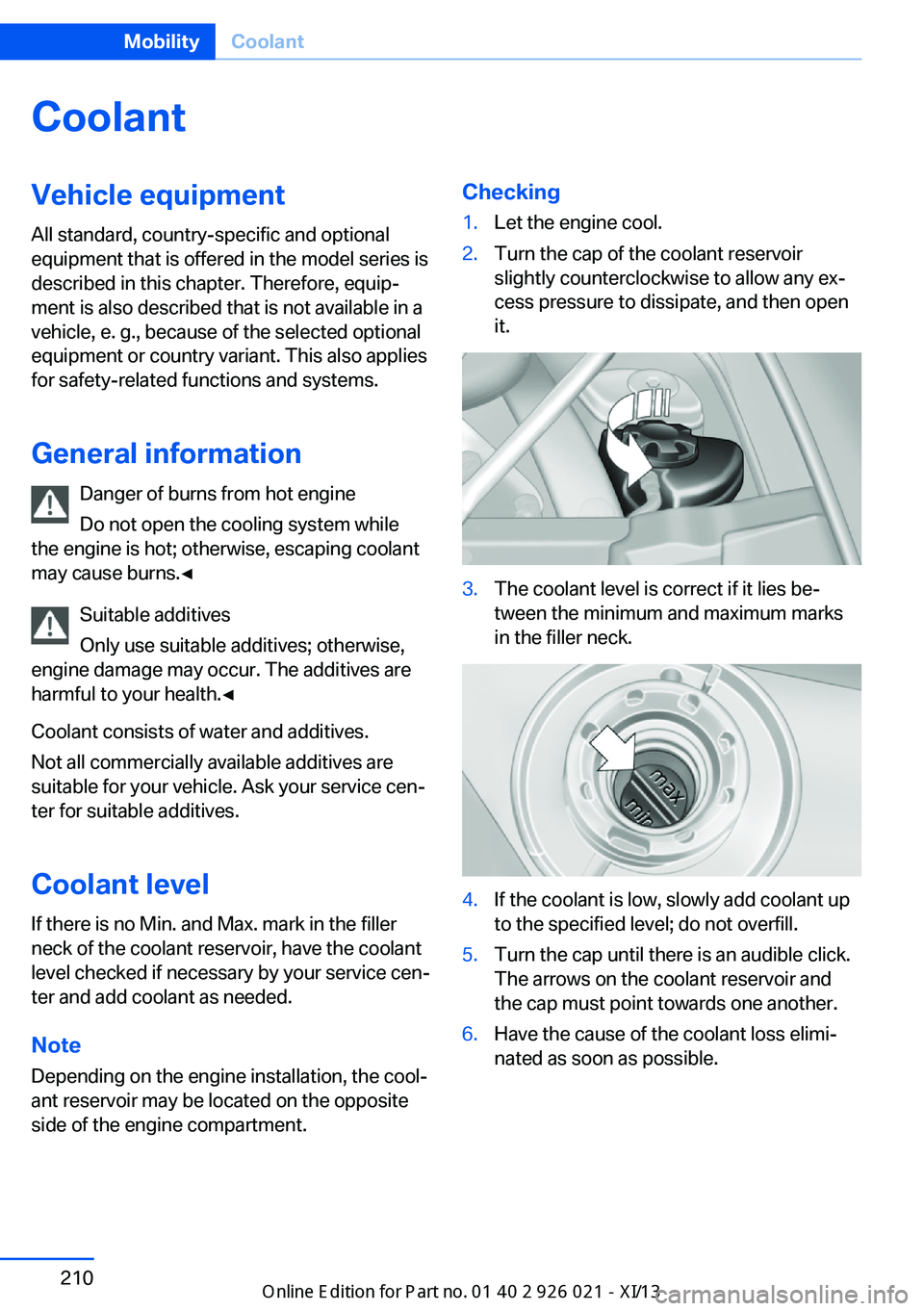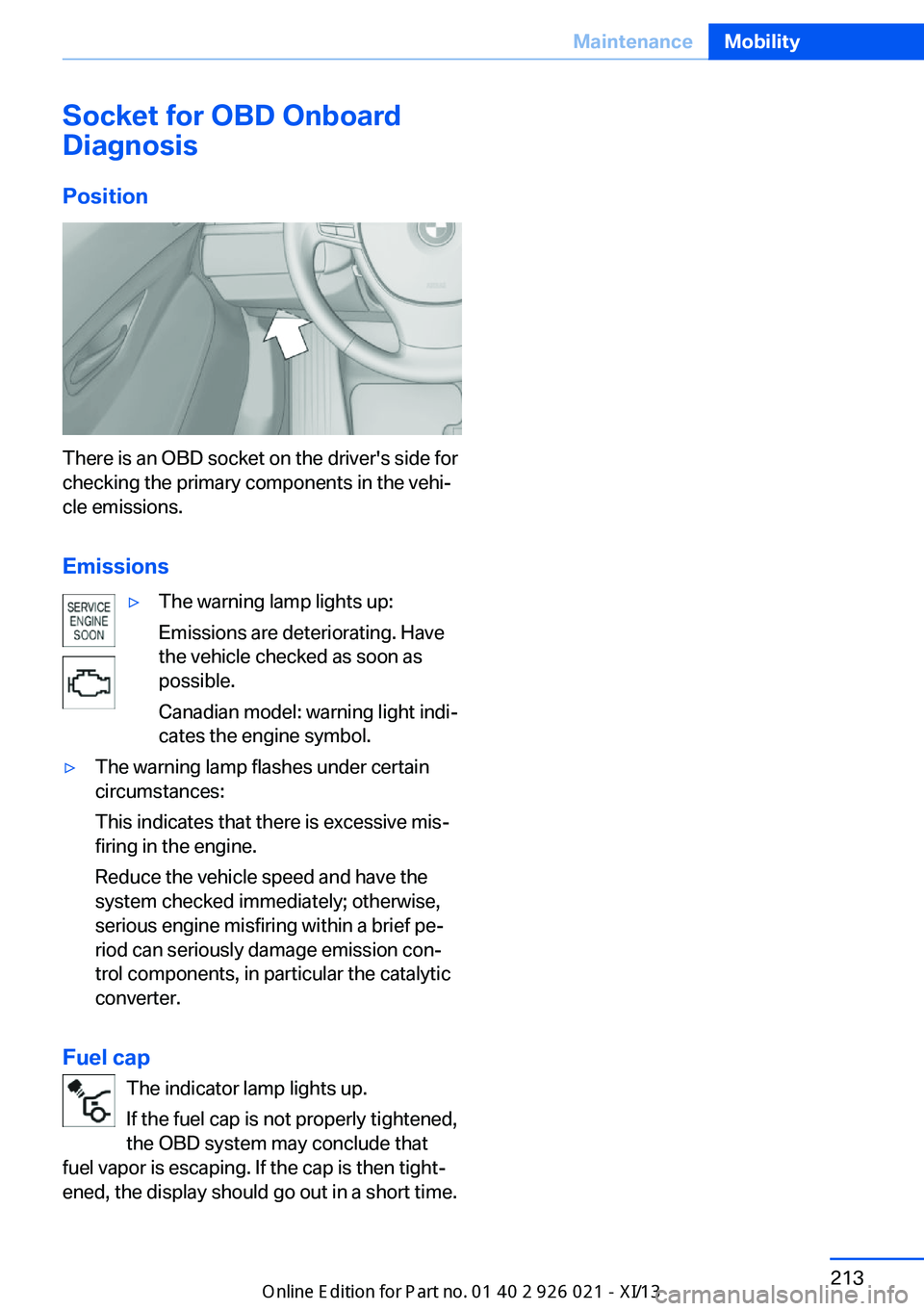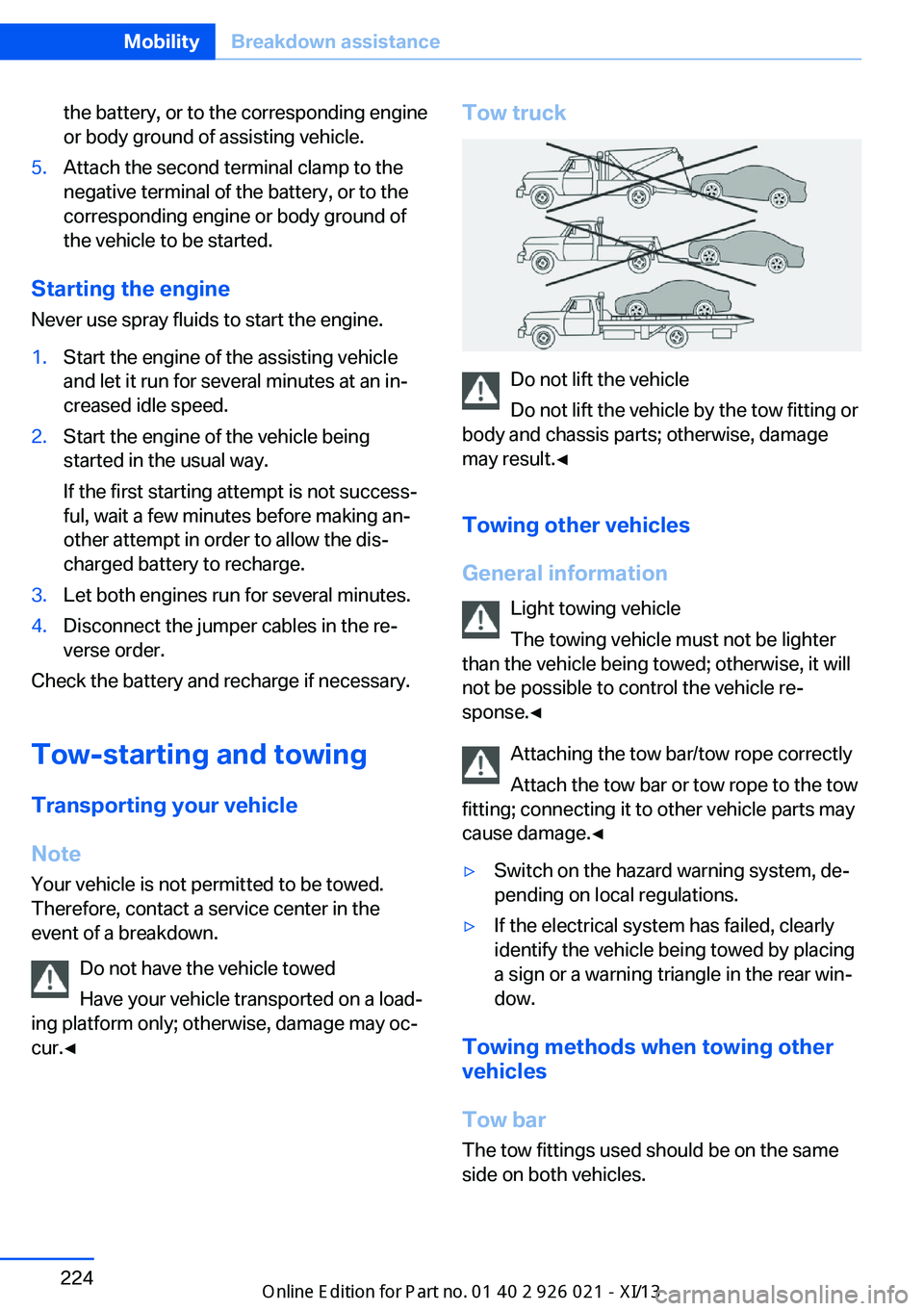check engine light BMW ACTIVE HYBRID 7 2013 F04 User Guide
[x] Cancel search | Manufacturer: BMW, Model Year: 2013, Model line: ACTIVE HYBRID 7, Model: BMW ACTIVE HYBRID 7 2013 F04Pages: 253, PDF Size: 5.01 MB
Page 214 of 253

CoolantVehicle equipmentAll standard, country-specific and optional
equipment that is offered in the model series is
described in this chapter. Therefore, equip‐
ment is also described that is not available in a
vehicle, e. g., because of the selected optional
equipment or country variant. This also applies
for safety-related functions and systems.
General information Danger of burns from hot engine
Do not open the cooling system while
the engine is hot; otherwise, escaping coolant may cause burns.◀
Suitable additives
Only use suitable additives; otherwise,
engine damage may occur. The additives are
harmful to your health.◀
Coolant consists of water and additives.
Not all commercially available additives are
suitable for your vehicle. Ask your service cen‐
ter for suitable additives.
Coolant level
If there is no Min. and Max. mark in the filler
neck of the coolant reservoir, have the coolant
level checked if necessary by your service cen‐
ter and add coolant as needed.
Note Depending on the engine installation, the cool‐
ant reservoir may be located on the opposite side of the engine compartment.Checking1.Let the engine cool.2.Turn the cap of the coolant reservoir
slightly counterclockwise to allow any ex‐
cess pressure to dissipate, and then open
it.3.The coolant level is correct if it lies be‐
tween the minimum and maximum marks
in the filler neck.4.If the coolant is low, slowly add coolant up
to the specified level; do not overfill.5.Turn the cap until there is an audible click.
The arrows on the coolant reservoir and
the cap must point towards one another.6.Have the cause of the coolant loss elimi‐
nated as soon as possible.Seite 210MobilityCoolant210
Online Edition for Part no. 01 40 2 909 774 - VI/13
Page 217 of 253

Socket for OBD Onboard
Diagnosis
Position
There is an OBD socket on the driver's side for
checking the primary components in the vehi‐
cle emissions.
Emissions
▷The warning lamp lights up:
Emissions are deteriorating. Have
the vehicle checked as soon as
possible.
Canadian model: warning light indi‐
cates the engine symbol.▷The warning lamp flashes under certain
circumstances:
This indicates that there is excessive mis‐
firing in the engine.
Reduce the vehicle speed and have the
system checked immediately; otherwise,
serious engine misfiring within a brief pe‐
riod can seriously damage emission con‐
trol components, in particular the catalytic
converter.
Fuel cap
The indicator lamp lights up.
If the fuel cap is not properly tightened,
the OBD system may conclude that
fuel vapor is escaping. If the cap is then tight‐
ened, the display should go out in a short time.
Seite 213MaintenanceMobility213
Online Edition for Part no. 01 40 2 909 774 - VI/13
Page 220 of 253

If a bulb fails, switch on the front fog lamps and
continue the trip with great care. Comply with
local regulations.
Do not perform work/bulb replacement
on xenon headlamps
Have any work on the xenon lighting system,
including bulb replacement, performed only by
a service center. Due to the high voltage
present in the system, there is the danger of
fatal injuries if work is carried out improperly.◀
For checking and adjusting headlamp aim,
please contact your BMW center.
Light-emitting diodes (LEDs)
Follow the general instructions on Lamps and
bulbs, refer to page 214.
With Xenon-headlamps, the following lamps
are designed with LED technology:▷Parking lamps and roadside parking lamps.▷Turn signals, incl. side indicators▷Daytime running lights
Contact your service center in the event of a
malfunction.
Turning lamp with the Xenon
headlamp
Follow the general instructions on lamps and
bulbs, refer to page 214.
The illustration shows the left side of the en‐ gine compartment.
55-watt bulb, H7.1.Open the folding cover in the engine com‐
partment.2.Turn the cap and remove it.3.Pull the connector off the bulb.4.Squeeze the wire bracket together and de‐
tach.5.Remove the bulb and replace it.6.Insert the new bulb and attach the cover in
the reverse order.Seite 216MobilityReplacing components216
Online Edition for Part no. 01 40 2 909 774 - VI/13
Page 228 of 253

the battery, or to the corresponding engine
or body ground of assisting vehicle.5.Attach the second terminal clamp to the
negative terminal of the battery, or to the
corresponding engine or body ground of
the vehicle to be started.
Starting the engine
Never use spray fluids to start the engine.
1.Start the engine of the assisting vehicle
and let it run for several minutes at an in‐
creased idle speed.2.Start the engine of the vehicle being
started in the usual way.
If the first starting attempt is not success‐
ful, wait a few minutes before making an‐
other attempt in order to allow the dis‐
charged battery to recharge.3.Let both engines run for several minutes.4.Disconnect the jumper cables in the re‐
verse order.
Check the battery and recharge if necessary.
Tow-starting and towing Transporting your vehicle
Note
Your vehicle is not permitted to be towed.
Therefore, contact a service center in the
event of a breakdown.
Do not have the vehicle towed
Have your vehicle transported on a load‐
ing platform only; otherwise, damage may oc‐
cur.◀
Tow truck
Do not lift the vehicle
Do not lift the vehicle by the tow fitting or
body and chassis parts; otherwise, damage
may result.◀
Towing other vehicles
General information Light towing vehicle
The towing vehicle must not be lighter
than the vehicle being towed; otherwise, it will
not be possible to control the vehicle re‐
sponse.◀
Attaching the tow bar/tow rope correctly
Attach the tow bar or tow rope to the tow
fitting; connecting it to other vehicle parts may
cause damage.◀
▷Switch on the hazard warning system, de‐
pending on local regulations.▷If the electrical system has failed, clearly
identify the vehicle being towed by placing
a sign or a warning triangle in the rear win‐
dow.
Towing methods when towing other
vehicles
Tow bar The tow fittings used should be on the same
side on both vehicles.
Seite 224MobilityBreakdown assistance224
Online Edition for Part no. 01 40 2 909 774 - VI/13
Page 245 of 253

Electronic displays, instru‐ment cluster 86
Electronic Stability Program ESP, refer to DSC 130
Emergency detection, remote control 35
Emergency release, door lock 39
Emergency release, fuel filler flap 196
Emergency release, parking brake 75
Emergency Request 221
Emergency service, refer to Roadside Assistance 222
Emergency start function, en‐ gine start 35
Emergency unlocking, trunk lid 43
Energy recovery, CHARGE 74
Engine, automatic off 72
Engine compartment 206
Engine compartment, work‐ ing in 206
Engine coolant 210
Engine oil 208
Engine oil, adding 209
Engine oil additives 209
Engine oil change 209
Engine oil filler neck 209
Engine oil temperature 88
Engine oil types, alterna‐ tive 209
Engine oil types, ap‐ proved 209
Engine start during malfunc‐ tion 35
Engine start, jump-start‐ ing 222
Engine temperature 88
Entering/exiting vehicle, as‐ sistance, steering wheel 64
Entering a car wash 227
Equipment, interior 167 ESP Electronic Stability Pro‐
gram, refer to DSC 130
Exchanging wheels/tires 203
Exhaust system 182
Exterior mirror, automatic dimming feature 63
Exterior mirrors 62
External start 222
External temperature dis‐ play 89
External temperature warn‐ ing 89
Eyes for securing cargo 186
F
Failure message, refer to Check Control 86
False alarm, refer to Uninten‐ tional alarm 47
Fan, refer to Air flow 160
Fault displays, refer to Check Control 86
Filler neck for engine oil 209
Fine wood, care 229
First aid kit 222
Fitting for towing, refer to Tow fitting 225
Flat tire, changing wheels 218
Flat Tire Monitor FTM 108
Flat tire, Tire Pressure Moni‐ tor TPM 110
Flat tire, warning lamp 109, 111
Flooding 183
Floor carpet, care 230
Floor mats, care 230
Folding table in the rear 172
Fold-out position, windshield wipers 80
Foot brake 183
Front airbags 105
Front fog lamps 103
Front fog lamps, bulb replace‐ ment 217 Front passenger airbags, au‐
tomatic deactivation 107
Front passenger airbags, indi‐ cator lamp 107
Front passenger seat, adjust‐ ing 53
Front turn signals, refer to Light-emitting diodes,
LEDs 216
FTM Flat Tire Monitor 108
Fuel 198
Fuel cap 196
Fuel consumption, refer to Average fuel consump‐
tion 94
Fuel filler flap 196
Fuel gauge 88
Fuel quality 198
Fuel recommendation 198
Fuel, tank capacity 236
Functions, hybrid system 30
Fuse 220
G
Garage door opener, refer to Integrated universal remote
control 167
Gasoline 198
Gasoline quality 198
Gear change, automatic transmission 82
Gear shift indicator 91
General driving notes 182
Gentleman function 53
Glass sunroof, powered 50
Glove compartment 173
Gross vehicle weight, ap‐ proved 235
Gross weight, permissible for trailer towing 235
H
Handbrake, refer to Parking brake 74 Seite 241Everything from A to ZReference241
Online Edition for Part no. 01 40 2 909 774 - VI/13